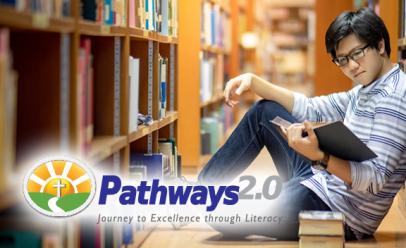 By: Kendall Hunt Publishing with contributions from the writing team of Pathways2.0 Reading and Language Arts programs (grades 1-8)
By: Kendall Hunt Publishing with contributions from the writing team of Pathways2.0 Reading and Language Arts programs (grades 1-8)
The possibilities for the use of faith-based reading in the classroom are nearly limitless!
Among the many focuses of a reading instructor, one of the primary goals is building students literacy skills and love for literature. In a faith-based classroom, however, teachers often have further goals for their students. As noted by Bette Bosma and Kathryn Blok, retired Professors of Education, these goals include creating an awareness of how reading and reading materials can be used to strengthen personal worship, helping us live in social relationships as God would have us, and assisting us in doing the world’s work as God would have us. In doing so, teachers encourage and promote a desire to read with a faith-based worldview lens to process and understand the text.
For such teachers, faith-based reading, is reading that includes both fiction and nonfiction texts with religious themes or written from a religious perspective, as well as the discussion of nonreligious texts from a faith-based perspective. This is an important component of reading instruction overall.
The Pathways2.0 (grades 1-8) curriculum features faith-based reading in forms of Anchor Text and Paired Text correlating with the theme of each unit. For example, the Heroes unit theme asks students to focus on the Essential Question, “What can we learn from heroes that will enable us to be heroes for God?”. Through the reading of and reflection on the texts in this unit, students explore answers to this question and develop their own personal, faith-based perspectives on what it means to be a hero.
The benefits of faith-based reading are many, including the following:
· Helping readers make good choices
· Giving readers appropriate role models
· Encouraging positive characteristics, such as kindness and compassion
· Promoting Christian values, such as cooperation rather than competition
These benefits will take different forms for students of different ages. For example, younger children may wish to emulate the hero of a recently read book by sharing their toys the way the character did. Whereas older students may have a meaningful revelation as a result of well-written text, such as the realization that material things can’t satisfy the human soul.
For students of all ages, the overall benefit of faith-based reading is that it strengthens their literacy skills while also deepening their understanding of the world from a faith-based perspective that promotes positive values.
Generally, the texts used in faith-based reading feature themes aligned with the values of a specific faith or are written from the perspective of a particular faith. But as mentioned earlier on in the definition of faith-based reading, a text doesn’t necessarily need to have religious themes to be used in a faith-based lesson. The teacher can use any appropriate text for faith-based language arts instruction by focusing the classroom discussion on aspects of the text in relation to faith-based issues and values and by crafting extension activities aimed at promoting those values. For example, to help students explore a text from a faith-based perspective, teachers might ask questions like:
· Does this character remind you of anyone in the Bible? How is the character the same or different? (younger children)
· What can you do to show people that you appreciate their help? (younger children)
· How might this situation have ended differently if the character had put his/her faith in God? (older children)
· What advice do you wish you could give this character that would help her/him resolve this difficult situation? (older children)
For younger children, the focus is often on personal characteristics and values and what one wants versus what is right in a given situation. For older children and teens, the focus widens to include major issues, such as the meaning of life and finding our place in God’s world.
Extension activities in faith-based reading also take different forms depending on the age of the student. For younger children, activities are often simple, such as writing a class thank-you note that shows appreciation for the community’s firefighters. In this activity, the teacher can focus on both specific literacy skills, such as the different parts of a letter, as well as Christian values, such as service to others and giving thanks.
For older learners, teachers can create activities that give students the opportunity to use their literacy skills and faith-based values for the betterment of their communities. For example, a project to present to the school’s administration in which students collaboratively develop a proposal for a faith-based, after-school tutoring program. This would involve literacy skills specific to formal persuasive writing while also promoting the values of collaboration and volunteerism.
The possibilities for the use of faith-based reading in the classroom are nearly limitless, and the outcomes are essential. Students with strong literacy skills and strong values can use their strengths for the betterment of their communities and the global community.
Bette Bosma and Kathyrn Blok, A Christian Perspective on the Teaching of Reading (Grand Rapids, MI: Calin College, 1992).